|
EVER SINCE archeologists
and historians turned their talents to deciphering the unrecorded
past, human beings have dreamed of simplifying the problem for
scientists of the future, deliberately preparing a message from
our time to theirs.
Until recently this
perennial dream has been only a dream. The problem of preserving
such a record is extremely difficult. Crypts on the earth's surface,
no matter how strong, offer obvious temptation to vandals. Most
materials suitable to be deposited in the earth are subject to
rapid corrosion, or are too brittle or too difficult to find
after burial. Too little was known about the effects of time
to permit anyone confidently to design a vessel for the future.
A few months ago engineers of the Westinghouse
Electric & Manufacturing Company decided that the advance
of technology had removed these difficulties at last, and what
hitherto had seemed impossible could now be done.
Early in 1938 they decided upon building a
"Time Capsule" capable of lasting 5,000 years -- a
period of time almost as long as that of all recorded history.
Five thousand years ago the pyramids were still unbuilt. The
peoples of that time had discovered metals, and were using metallic
alloys. They had learned how to write down human speech and record
language on clay tablets and stone. They understood commerce;
they knew how to build huge cities. But they had not yet devised
the alphabet, and they did not know of the existance of iron.
Casting the Capsule's shell
in molten Cupaloy
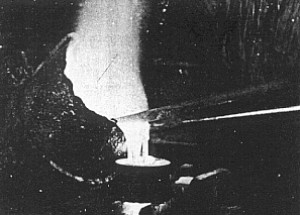 |
Five thousand years from now the peoples of
the future will look back upon us as we look back on the early
Egyptians, Sumerians and Babylonians. It was the plan of Westinghouse
engineers to provide them with more knowledge of us than we have
of any of the ancient peoples who lived before us.
Three Major Problems
This project clearly required the solution
of three great problems.
The first was, how to build a vessel capable
of lasting 5,000 years, and how to preserve it for posterity.
The second, how to leave word of its where-abouts
for historians of the future.
The third, the selection and preservation
of its contents.
Each of these problems was carefully considered.
At each step, counsel was taken with archaeologists, historians,
technical and scientific men, hundreds of whom participated with
Westinghouse in the working out of this project. A Time Capsule
Committee was formed, which established sub-committees to study
the various questions relating to the plan.
A sub-committee headed by M.W. Smith, Westinghouse
Manager of Engineering, undertook the solution of the first problem:
that of designing and constructing the Time Capsule. It was decided
that the best material would be a metallic alloy of high corrosion
resistance and considerable hardness, non-ferrous (containing
no iron), and preferably consisting principally of copper, oldest
of the metals used by man.
Careful hands
fashion the Capsule
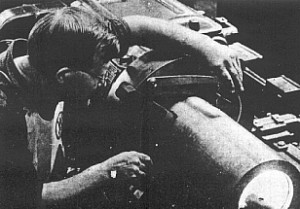 |
The Capsule
begins to take final form
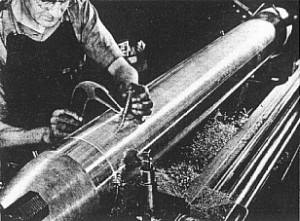 |
A new alloy of copper, known as Cupaloy (copper
99.4 per cent, chromium 0.5 per cent, silver 0.1 per cent) was
found most nearly to fulfill the specifications. Like that reputed
to have been used by the ancient Egyptians, the secret of which
has been lost, this metal can be tempered to the hardness of
steel, yet has a resistance to corrosion equal to pure copper.
Also -- of great importance -- in electrolytic reactions with
iron-bearing metals in the soil it becomes the anode and therefore
will receive deposits instead of wasting away, as do buried water-pipes
and other iron alloys. Moreover, Cupaloy is especially resistant
to corrosion in salt water.
For reasons of strength and convenience, the
Time Capsule was shaped like a torpedo, seven and a half feet
long and eight and three-eighths inches in diameter. The outer
shell consists of seven cast segments of Cupaloy, threaded, screwed
together hard, and sealed with molten asphalt. The nearly invisible
joints have been preened out and the outer surface burnished.
The walls of the Cupaloy segments are one inch thick, thus leaving
an inner crypt six and three-eights inches in diameter and six
feet, nine inches long. The crypt is lined with an envelope of
Pyrex glass, set in a water-repellent petroleum base wax. Washed,
evacuated and filled with humid nitrogen, an inert, preservative
gas, this glass inner crypt contains the "cross-section"
of our time.
For the Guidance of "Futurians"
The second great problem, that of how to leave
word of the whereabouts of the Time Capsule, was met by preparing
a BOOK OF RECORD OF THE TIME CAPSULE, printed on permanent paper
with special inks. Copies have now been distributed to libraries,
museums, monasteries, convents, lamasaries, temples and other
safe repositories throughout the world.
Inspectors follow every detailed
step
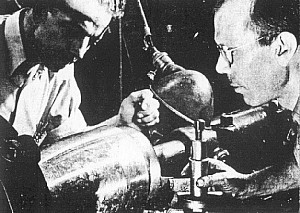 |
The BOOK OF RECORD was prepared after detailed
consultation with libraries, museum authorities, printers and
bookbinders. Suggestions for binding and general treatment were
obtained from the office of the National Archives, the New York
Public Library, the American Library Association and other sources.
The United States Bureau of Standards furnished specifications
for the permanent paper and inks. A special run of 100-pound
rag book paper was manufactured for the book. The pages of each
copy were sewn together by hand with linen thread. A portion
of the edition was bound in royal blue buckram stamped with genuine
gold. The remainder was bound in handmade flexible paper, stamped
with aluminum.
The Book of Record and the
Holy Bible
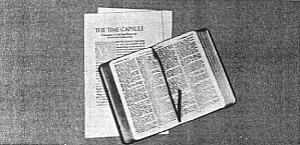 |
In order that the appearance of the BOOK OF
RECORD might match its permanence, Frederic W. Goudy, one of
the foremost type designers, typographers and printers of our
time, consented to design the book and set a portion of the type.
Exactly 3,650 copies were printed, of which 2,000 (including
one buried in the Time Capsule) were bound in flexible paper,
and 1,650 in buckram.
The BOOK OF RECORD contains a message to posterity
asking that it be preserved and translated into new languages
as they appear; a description of the Capsule's contents, and
the exact latitude and longitude of the deposit as determined
by the U.S. Coast and Geodetic Survey to the third decimal point
in seconds. The geodetic coordinates are tied into the Survey's
national network, on which astronomical as well as geodetic data
are given. In addition, instructions are included for making
and using instruments to locate the Time Capsule by the methods
of electromagnetic prospecting.
That our tongue may be preserved, the book
contains an ingenious "Key to the English Language"
devised by Dr. John P. Harrington, of the Smithsonian Institution.
By means of simple diagrams the peculiarities of English grammar
are explained; a mouth map shows how each of the 33 sounds of
English are pronounced. A 1,000-word vocabulary of "High
Frequency English" spelled in the ordinary way and neo-phonetically,
is provided. In itself the Key is believed to contain all the
elements archaeologists of the future will need to translate
and pronounce 1938 English, but to make doubly certain, the Time
Capsule itself also contains multi-lingual texts, a dictionary
and a lexicon of slang and colloquial English.
Also contained in the BOOK OF RECORD are messages
to the future from three famous men of our time: Dr. Albert Einstein,
Dr. Robert Millikan and Dr. Thomas Mann. A table of common measures
in the English and Metric system is given, including a statement
of the length of the standard meter in terms of the wavelength
of red cadmium light -- a constant that will never vary, no matter
what other systems of measurements are in use 5,000 years from
now.
Selecting the Contents
Choosing what was to go into the limited space
of the Time Capsule crypt proved perhaps the most difficult problem
of all, because nothing short of an enormous gallery of vaults
could accommodate all the objects and records of any civilization.
The Time Capsule Committee turned for advice
to archaeologists, historians and authorities in virtually every
field of science, medicine and the arts. On the basis of their
helpful suggestions, the Committee chose to include some thirty-five
articles of common use, ranging from a slide rule to a woman's
hat, each selected for what it might reveal about us to the future
archaeologists. Also included are about seventy-five samples
of common materials, ranging from fabrics of various kinds, metals,
alloys, plastics, and synthetics to a lump of anthracite and
a dozen kinds of common seeds.
The woman's hat, specially
designed by Lilly Dache, was the last object packed in the Capsule
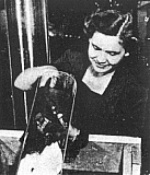 |
These material items, however, are only supplementary
to a voluminous essay about us and our times, reduced to microfilm.
On three an a half small reels there are reproduced books, articles,
magazines, newspapers, reports, circulars, catalogs, pictures;
discussing in logical order where we live and work, our arts
and entertainment, how information is disseminated among us,
our general information, our religions and philosophies, our
education and educational systems, our sciences and techniques,
our earth, its features and peoples; medicine, public health,
dentistry and pharmacy, our major industries and other subjects.
This "Micro-File" comprises more than 22,000 pages
of text and 1,000 pictures; a total of more than 10,000,000 words.
It would take an ordinary person more than a year to read all
of it; more than a decade to assimilate all this knowledge. Probably
no man living knows as much about us as those who study this
Time Capsule will know.
A small microscope is included for reading
the microfilm; also instructions for making a larger, more comfortable
reading machine, such as those used in libraries and newspaper
offices for this purpose. There are likewise instructions for
making various kinds of modern instruments, including a motion
picture projection machine. For use with this, three reels of
newsreel are contained in the Time Capsule, showing about twenty
characteristic, significant or historic scenes of our times,
complete with sound, and ranging all the way from an address
by President Roosevelt to a Miami fashion show. The newsreel
was especially edited for the Capsule by RKO-Pathe Pictures,
Inc.
Packing the Time Capsule
The utmost care was taken in packing the contents.
Under the direction of representatives of the United States Bureau
of Standards each object was examined to determine whether it
could be expected to last 5,000 years. All articles containing
volatile solvents were ruled out; also all materials which might
decompose with the production of fumes or acids that might attack
other articles in the crypt. No liquids of any kind were permitted
in the crypt. Organic objects, such as seeds, were sealed in
special gas-tight capsules.
Every object enclosed in the Capsule was then
fully labeled and described. The glass capsules containing seeds
and other objects contain labels sealed into the glass. All other
objects were individually wrapped in heavy 100 per cent rag ledger
paper and tied with linen twine, with the label wrapped inside.
Where it was necessary to use paste to attach a label, only pure
gum arabic was used. Film, including both the microfile and newsreel,
was enclosed in special spun aluminum containers, lined with
rag paper.
The position of each object in the crypt was
determined by its weight. The heavier objects are packed in the
bottom, resting on a cushion of glass wool. The seven containers
of film rest about mid-way in the crypt. The lighter objects,
including the woman's hat, are placed on top. The hat was stuffed
with surgical cotton to preserve its shape, and wrapped in paper.
All spaces between the objects in the crypt were cushioned and
made firm with glass wool.
Witnesses at the Capsule's
packing: F.D. McHugh, David S. Youngholm of Westinghouse, C.G.
Weber; seated, Grover A. Whalen
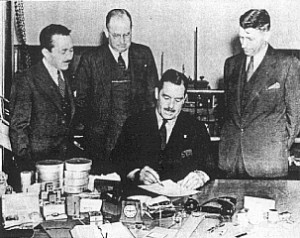 |
The process of packing was conducted in the
presence of three official witnesses: C.G. Weber, of the United
States Bureau of Standards; F.D. McHugh, managing editor of the
Scientific American, and Grover Whalen, president of the
New York World's Fair 1939. A checklist of contents, bearing
the signatures of the witnesses, was the last thing included
in the crypt.
Immediately following the packing, the Pyrex
inner crypt was placed upon a glass-lathe, heated and sealed.
The air was then drawn out through a small tube, the contents
washed with inert gas, and the crypt filled with nitrogen, to
which just enough moisture was added to equal the humidity of
an ordinary room. Protected from oxygen and excess moisture by
this inert, humid atmosphere, the contents are expected to remain
in their present condition indefinitely. When archaeologists
of the future open the Time Capsule they will probably find the
film, fabrics, metals and other materials as fresh and "new"
as they day they were put in.
The final step in the preparation of the Capsule
was the insertion of the glass inner crypt into the outer Cupaloy
shell. Before this was done, the Pyrex envelope was wrapped with
several layers of glass tape to increase its strength. Both the
Cupaloy outer shell and the packed crypt were then gently warmed
in electric ovens to encourage the flow and penetration of the
waterproof wax. After the inner crypt was in place, the Capsule
was raised upright, and the wax poured in around the glass. "Shrink-fitting"
the final Cupaloy joint was then accomplished by chilling the
heavy cap to several degrees below zero with dry ice, then turning
it into place on tapered threads. When permitted to warm up to
the same temperature as the rest of the Capsule, the natural
expansion of the metal caused the threads to seize so tightly
as to form an air-and-water-tight joint.
Sealing the packed inner crypt
was a delicate task
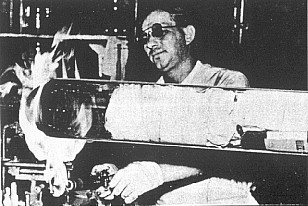 |
Depositing the Capsule for the Future
The Time Capsule is preserved for posterity
at the site of the New York World's Fair 1939; chosen because
New York will certainly be an attractive place for archaeologist
5,000 years from now, as are the sites of ancient Athens, Rome
and Troy in our own time.
It was lowered fifty feet into the earth on
the site of the Westinghouse Building at the grounds of the World's
Fair at high noon on September 23, 1938, the precise moment of
the Autumnal Equinox. While a Chinese gong tolled solemnly, A.W.
Robertson, Chairman of the Board of the Westinghouse Electric
& Manufacturing Company, committed the Time Capsule to posterity
with these words: "May the Time Capsule sleep well. When
it is awakened 5,000 years from now, may its contents be found
a suitable gift to our far-off descendants."
The Capsule made its descent into the earth
thorough a steel pipe ten inches in diameter, and came to rest
upon a block of waterproof cement. Before this well is finally
closed, the Capsule will be entombed in pitch and an additional
layer of concrete, after which the steel pipe will be cut off
and withdrawn. The land where it lies will become a city park
after the Fair, and the site of the Time Capsule may be marked
with a shaft or boulder. During the Fair a replica of the Capsule,
and duplicates of all the objects, books and other items it contains,
will be on view in the Westinghouse Building.
A.W. Robertson, Westinghouse
Chairman, and Grover A. Whalen guide the Time Capsule to its long
resting place
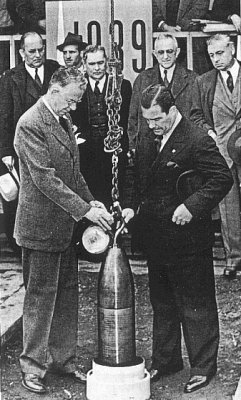 |
Safe from Vandalism and Sinking
Many questions are asked about the time Capsule
project, the principal one being, how will it be protected from
thieves or persons whose curiosity is greater than their sense
of obligation to the future?
The problem of keeping the Capsule safe from
vandals is believed to be well taken care of by the site selected
for burial. Sunk fifty feet below the surface of the ground,
in swampy soil, recovery will involve an expensive and difficult
engineering operation, costing many times the possible intrinsic
worth of the Capsule for its metal and saleable contents.
Another question often discussed is whether,
5,000 years from now, the coast will have sunk so far as to drown
the area. Consultation with geologists and the U.S. Coast and
Geodetic survey indicate that there is probably no foundation
for the common notion that the East Coast is sinking. Surveys
extending over the last 40 years show that if there is any sinking
at all, the rate is so slow that the change in level in 5,000
years would be only a few feet. The elevation at the site of
the Time Capsule is about 20 feet above sea level.
As to the third question frequently asked:
will it ever be found again? Westinghouse engineers can only
reply that every precaution has been taken, through the BOOK
OF RECORD, to guide archaeologists of the future to the exact
spot. If the people of the distant future wish to find it, they
can probably do so, even though it should migrate in the earth,
or sink. And even if all else fails, we may depend on the perennial
curiosity and the digging and burrowing habits of the human race,
to unearth it sooner or later. In the words of Dr. Clark Wissler,
Dean of the Scientific Staff of the American Museum of Natural
History, and one of the foremost archaeologists in the United
States:
"We have been told that such efforts
as ours here are futile; that, alter all existing civilizations
have died out and new civilizations come to be, no one will find
this record, or if they do perchance discover it, they will not
be able to make anything out of it. But the chances are good
that these records will be found and that they can be interpreted."
|